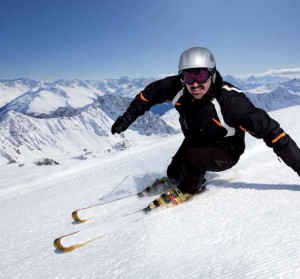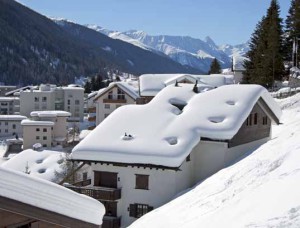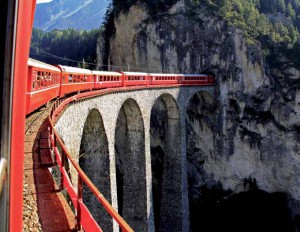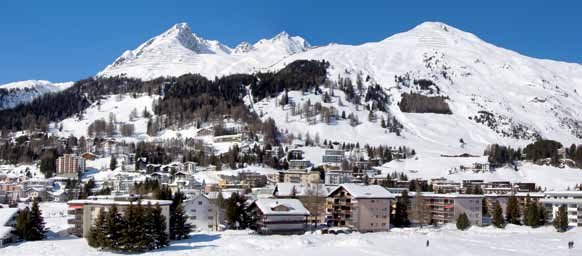Every January, thousands of people ascend to the Swiss mountain resort of Davos. Made famous by the World Economic Forum’s Annual Meeting – first held there in 1971 – Dianna Rienstra and David Watkiss discovered that Davos is much more than a crossroads where the rich and famous meet, greet and negotiate
Nestled in a picturesque valley in East Switzerland in the canton of Graubünden and flanked by the Landwasser River, the village of Davos is typically home to about 12,000 residents and a highly amusing population of mountain dogs.
It is a charming resort with multiple restaurants, cafes, bars, shops, art galleries and museums. Thomas Mann captured its spirit in his 1924 novel, The Magic Mountain, and the German impressionist painter Ernst Ludwig Kirchner’s work is housed at the eponymous museum.
Renowned for its rejuvenating mountain air, Davos launched itself as a health resort in 1860 and as a sports centre in 1930. The hearty, Swiss German-speaking locals are hospitable and apparently don’t mind the 2,500-plus people who book all accommodation, fill the restaurants and crowd the ski slopes for five days every January during the World Economic Forum’s Annual Meeting. They also seem unbothered by hundreds of Swiss army officers who patrol the streets, oftentimes barricading them for security purposes to protect heads of state, ministers and captains of industry.
“RUMOUR HAS IT THAT KLOSTERS IS FALLING OUT OF ROYAL FAVOUR”
The meeting has spilled into neighbouring Klosters where Britain’s Prince Charles and family have been skiing for three decades, although rumour has it that Klosters is falling out of royal favour, much to the consternation of local politicians and business owners.
SIX MOUNTAINS
The Davos-Klosters area is one of the largest ski resorts in Switzerland with six mountains – Jakobshorn, Madrisa, Parsenn, Pischa, Rinerhorn and Schatzalp – 300 km of pistes, 45 lifts and 85 descents. One pass for all mountains is available. Skiers and snowboarders of all levels can find ample diverse, beautiful and challenging terrain.
“THE SNOW EVENTUALLY DISAPPEARS TO REVEAL 700 KM OF WALKING PATHS”
The 360-degree views of the Alps from the top are stunning. Davos also has indoor and outdoor skating rinks, a sports centre and two sled runs. The snow, usually excellent between December and April, eventually disappears to reveal 700 km of walking paths and mountain bike trails.

LOCAL COLOUR
Just eight km from Davos, Klosters is imbued with old-world charm. However, those in search of nightlife had better stick to Davos. An exception is Gaudy’s Graströchni, a bar that can also be reached over a picturesque 14 km ski run from the top of Parsenn. Its bright yellow roof is reminiscent of a circus tent – and a circus is exactly what can be found inside. With music ranging from Eurotrash to Oom-Pah-Pah, ebullient locals, ski bums and tourists are packed together quaffing a wide range of drinks – ice cream shooters (miniature cones filled with liqueur and topped with chocolate and cream), tequila shots, hot wine, schnapps, beer, wine and Prosecco are all being consumed in large quantities, even though the Swiss measure out careful portions in decilitres.
WHERE TO STAY

Accommodation is surprisingly affordable. Many Davos hotels offer a free ski pass and double rooms starting at just SFr 87 (€72). There are dozens of hotels, hostels and self-catering apartments for couples or families. The magnificent Hotel Bélvèdere built in 1895 is around SFr 170 (€140) per night. Try the Hotel Schatzalp, opened in 1900 as a world-class sanatorium, starting at SFr 155 (€125), or at least have a drink, lunch or dinner in this otherworldly place, perched 300 metres above the village, accessible only by foot or funicular. Views are breathtaking and visitors can ski out from here to the nostalgic Schatzalp-Strela runs. But tobogganing 2.5 km down to the village after happy hour or dinner is ill advised.
EAT AND DRINK
Every type of cuisine is available, ranging from typical Swiss at the Pot Au Feu and Bistro Gentiana restaurants to Italian, Thai and Asian. The ArtHausHotel restaurant offers a feast for the eyes and world-class cuisine. The Hotel Europe’s Zauberberg Restaurant serves amazing Chinese, next to its piano bar and casino. However, this is Switzerland – rib-sticking cheese fondue and rösti are de rigeur in most places. Many restaurants – on or off the mountains – serve lunch and drinks outside, blankets included, but be sure to use sunscreen.
“BREAKFAST IS A TREAT ANYWHERE”
Restaurants and bars cater to all budgets, and cosy coffee houses abound. Breakfast is a treat anywhere, but Café Schneider’s is an institution and shrine to the canton’s famous Nusstorte – a dense, caramel-walnut pastry. End an evening at Ella’s Restaurant wine bar and jazz club or at one of the noisy-but-fun piano bars.
GETTING THERE

It would be a shame to miss the spectacular train ride from Zurich Airport via Landquart, lasting two hours and 45 minutes. Davos is also accessible via the Glacier Express, a train that chugs through the heart of the Swiss Alps over 291 bridges and through 91 tunnels, averaging 40 km per hour. The seven-and-a-half hour, 270 km trip includes crossing the Oberalp Pass at about 2,044 metres. Fine dining onboard is available at €25-€35.







